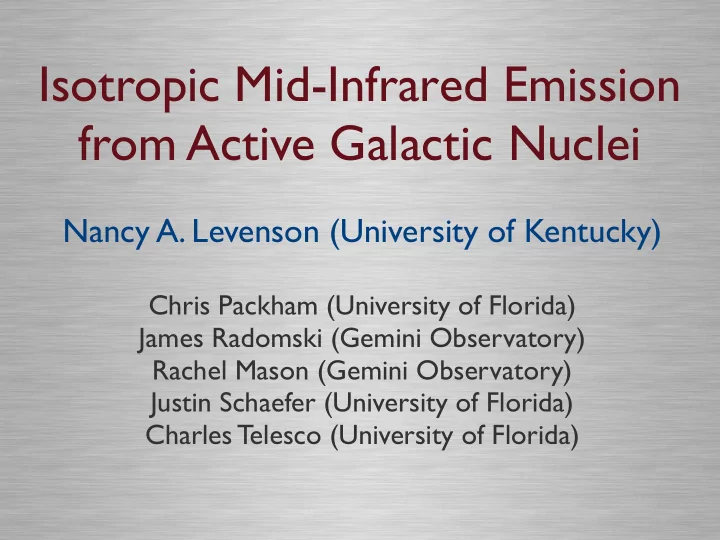

Isotropic Mid-Infrared Emission from Active Galactic Nuclei Nancy A. Levenson (University of Kentucky) Chris Packham (University of Florida) James Radomski (Gemini Observatory) Rachel Mason (Gemini Observatory) Justin Schaefer (University of Florida) Charles Telesco (University of Florida)
AGN unification Type 1 Type 2 * Optically and geometrically thick dusty torus reprocesses intrinsic AGN continuum to emerge in the infrared Infrared luminosity depends on intrinsic AGN luminosity
AGN unification -- smooth torus Type 1 Type 2 * Consequences for homogeneous torus: • Anisotropic MIR emission • Type 1 strong silicate emission; Type 2 deep silicate absorption
AGN unification -- smooth torus models (Pier & Krolik 1992)
Small torus T -ReCS (Díaz-Santos et al. 2008) • Small scale measurements are essential! torus size < 5pc star formation can contribute significantly on large scales • diffraction-limited observations with Gemini R 8 μ m ~ 0.3” (50pc at 30Mpc)
Small torus Spitzer (Díaz-Santos et al. 2008) • Small scale measurements are essential! torus size < 5pc star formation can contribute significantly on large scales • diffraction-limited observations with Gemini R 8 μ m ~ 0.3” (50pc at 30Mpc)
Small torus (Díaz-Santos et al. 2008) • Small scale measurements are essential! torus size < 5pc star formation can contribute significantly on large scales • diffraction-limited observations with Gemini R 8 μ m ~ 0.3” (50pc at 30Mpc)
Mid-infrared/X-ray correlations 45 • distance-limited sample Seyfert 1 Seyfert 2 D < 50 Mpc 44 • normal Seyfert galaxies intrinsic AGN luminosity 43 • fit PSF to MIR (to isolate log L X [erg s − 1 ] unresolved AGN) 42 • absorption-corrected L X is a proxy for L AGN 41 • X-ray variability 40 type 1 uncertainty 39 39 40 41 42 43 44 45 log L MIR [erg s − 1 ] (psf fitting) reprocessed emission (Levenson et al., in preparation)
Mid-infrared/X-ray correlations 45 • MIR and X-ray are Seyfert 1 Seyfert 2 strongly correlated 44 • no significant differences intrinsic AGN luminosity 43 between types 1 and 2 log L X [erg s − 1 ] isotropic MIR emission 42 • in agreement with previous work 41 e.g., Horst+ 2008, Gandhi+ 2009 40 39 39 40 41 42 43 44 45 log L MIR [erg s − 1 ] (psf fitting) reprocessed emission (Levenson et al., in preparation)
Mid-infrared/X-ray correlations • type 1 and type 2 are not significantly different isotropy of MIR emission Type 1 Type 2 *
Inhomogeneous (clumpy) torus • Nearly isotropic MIR emission with weak silicate features i σ * R d R o N ( R , β ) = N 0 exp( − β 2 / σ 2 )( R / R d ) − q (Nenkova et al. 2008)
Inhomogeneous (clumpy) torus * • individual clouds are optically thick ( τ V ≥ 20) • AGN directly heats some clouds • radiative transfer within dusty clouds • illuminated and dark sides may observed from both type 1 and 2
Inhomogeneous (clumpy) torus • clumpy torus models produce nearly isotropic MIR emission • isotropy increases toward longer wavelengths • isotropy increases with a more compact torus 10.0 Relative Flux Density i = 0 o i = 90 o 1.0 N 0 =4, σ =30 o , q=1, τ V =40 0.1 0 5 10 15 20 25 Wavelength ( µ m) (Levenson et al., in preparation)
Inhomogeneous (clumpy) torus • for a given model, MIR flux typically varies by less than 5x • considering all parameter combinations, absolute MIR luminosity varies by less than 600x 10.0 Relative Flux Density i = 0 o i = 90 o 1.0 N 0 =4, σ =30 o , q=2, τ V =60 0.1 0 5 10 15 20 25 Wavelength ( µ m) (Levenson et al., in preparation)
Inhomogeneous (clumpy) torus 8.8 μ m flux as a function of viewing angle: 15 σ =45 o , q=1 N 0 τ V 2 20 6 40 10 60 15 80 o ) 10 100 F 8.8 (i)/F 8.8 (90 5 0 0 20 40 60 80 Viewing angle (degrees) (Levenson et al., in preparation)
Mid-infrared/X-ray correlations • general agreement with 45 45 Seyfert 1 Seyfert 1 fit Seyfert 2 Seyfert 2 model theoretical predictions 44 44 • luminosity dependence here reduced L X with stronger MIR 43 43 log L X [erg s − 1 ] log L X [erg s − 1 ] • sources in addition to AGN 42 42 contribute to MIR nuclear star formation, 41 41 in variable amounts 40 40 39 39 39 39 40 40 41 41 42 42 43 43 44 44 45 45 log L MIR [erg s − 1 ] (psf fitting) log L MIR [erg s − 1 ] (psf fitting) (Levenson et al., in preparation)
Mid-infrared/X-ray correlations 45 45 Seyfert 1 fit Seyfert 2 model 44 44 43 43 log L X [erg s − 1 ] 42 42 X 41 41 40 40 39 39 39 40 41 42 43 44 45 39 40 41 42 43 44 45 log L MIR [erg s − 1 ] (psf fitting) log L MIR [erg s − 1 ] (fixed physical aperture) • fixed 100 pc aperture: no luminosity dependence • comparable star formation on these scales (Levenson et al., in preparation)
Conclusions • MIR and intrinsic (X-ray) luminosity are strongly correlated • MIR emission is effectively isotropic • account for these results with a clumpy AGN torus • more isotropic with longer wavelength • more isotropic with smaller torus • weak silicate features in emission and absorption • some luminosity dependence on MIR/X-ray correlation • understand as contamination by nuclear star-heated dust • not apparent on 100 pc scales
Recommend
More recommend